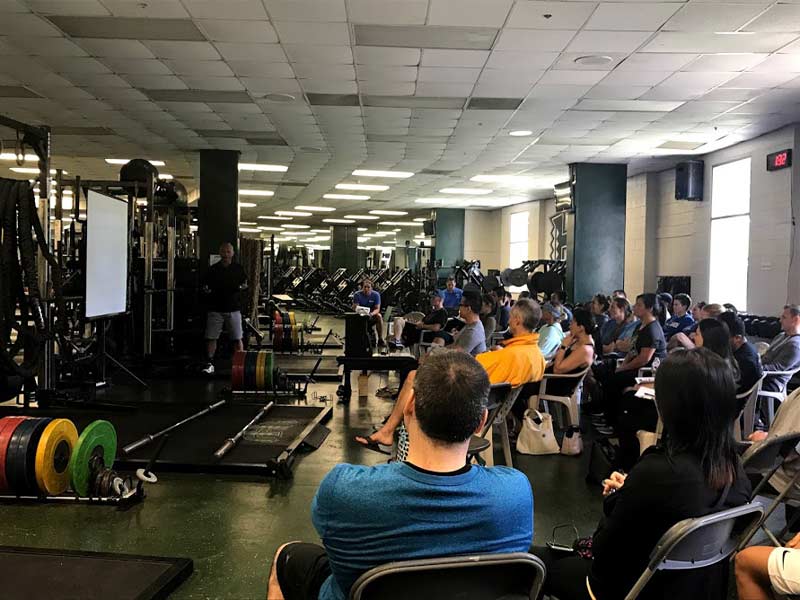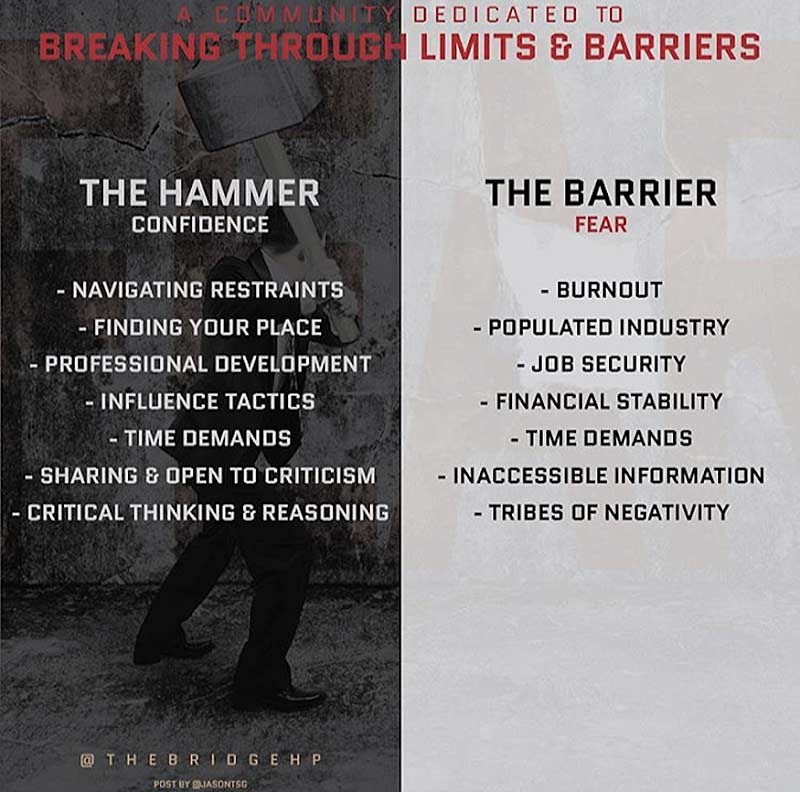[mashshare]

A version of this cycle occurs every day: Coaches are fired, coaches switch jobs, coaches look for jobs, coaches must take massive pay cuts, and some coaches decide either to strike out on their own or quit being a strength coach altogether, due to the vocational drought that has plagued our field for far too long. What’s perhaps even more alarming is the cycle is progressing far faster than we as a community are with actionable solutions. This is a problem, since coaches have bills to pay and families to feed just like any other professional.
Sure, it may rain dopamine every game day for all of us when we can be there to support our athletes during competition. However, once we go home, it can feel as if the well has run dry once we realize we’ve been “stuck” in the same role with the same level of pay for years, despite having more and more responsibilities placed upon us. Then again, we go around so much saying that “we don’t do it for the money” and that we are the hardest-working people in the room. So, can we really blame those who end up taking us at our word?
But I digress.
What is clear is that both the climate and the landscape of strength and conditioning are changing, and will continue to do so rapidly over the next 20+ years.

Never before has it been this hard for a strength and conditioning coach to find a sustainable job. This holds true regardless of your age, degrees/certifications held, and even the amount of “years in the trenches” you have to your name. When you stop to think about it, isn’t it a bit ironic that, while we often seem to create divides among the various sectors in the profession, it is unemployment of all things that unifies us, due to the widespread nature of the scarce resources and opportunities that exist in the field?
Perhaps it’s time we do something about this. Even if it involves starting at ground zero and taking baby steps by applying concepts of progressive overload to the management of our careers in the same way that we apply it within our training programs.
As much as many of us would like for it to be the case, no governing body or entity will save us. The solution will have to come from within and it will require a combination of ethics, strategy, and unity, especially if we hope to dig ourselves out of this hole anytime in the near future. Collectively, we are a community that, while strong-willed, is still far more adversarial with one another than we are advocates for one another. For us to advance, this will have to change as well.
As it stands, we tend to only like to see success for those who are like us, who don’t threaten us, or who agree with us. And heaven forbid if there is someone who has crossed over, created a unique avenue for themselves, or been awarded a higher-level management position within a team—we often react to those who exist in these categories by eventually rooting against them because they are now a guru or “big time.”
It’s time to wake up! Good, bad, or indifferent, those outside of our circle (media, administration, other professions, etc.) lump together all of us strength coaches in the same category, and it is their perception of us that partly dictates our reality.
In short, it is time to upgrade both our profession’s ethics and its image. Over the next year, my aim is to provide talking points and possible strategies as to how we can do this, one topic at a time. And since I’m writing this article as I sit on a plane after attending/speaking at a conference this weekend, the first topic of relevance we will look at is networking.
Networking Done Right
I’ll be honest: I dislike the term “networking” just as much as any of you, due to the stereotypical connotations associated with it. But as I stated in my book, we cannot get hung up on terminology and let our emotions dictate our thoughts and actions. Call it what you want, but the point is that people have approached this side of things the wrong way for far too long. It is especially relevant because all of us—regardless of age, status, job title, or experience level—will call upon members of our network for help at some point in time.
That is the purpose of a network: to help one another and bolster the collective’s chances of success for a common good. When done correctly, a network becomes a community: A two-way street, NOT a transaction. So how can we rip up the “old road” and pave a new path? Let’s start with the 11 tips mentioned below.

Be a Connector
Proper networking is about finding ways in which you can add value to the lives and careers of others. Ask yourself what problems you can help someone solve. Who can you introduce them to that may enjoy/benefit from their perspective? How can you make some part of their path easier?
#Networking done well is not about you, says @Coach_BrettB. Share on XThese are the questions you should lead with both internally and externally, as opposed to “How can I get noticed?” Networking done well is not about you.

Be Inclusive
Go to a clinic and you will often see young coaches swarming around those who work only in pro sports or at large institutions, while a number of lesser-known coaches, or those speaking on topics without sexy titles, get passed by or ignored altogether. This is a terrible mistake, not only on the part of the young professionals, but any coach in general.
Often, people only try to build relationships with those whom they admire, look up to, have heard about, or believe can help them. Again, networking is not about you and your desire for recognition or validation; it is about you being able to establish authentic connections that allow you or others to help more people down the road. It is about bridging a gap and finding ways to create positive change for as many coaches as possible, regardless of the setting or sector they work in.
In short, do not just try to connect with those you perceive to be “above” you, or those who have received numerous accolades. I’ve said it before: Some of the best strength coaches out there are those you have never heard of and who often coach in the most meager of settings. Title and status do not always equate to wisdom or value.
You should never be above learning from everyone and anyone, says @Coach_BrettB. Share on XYou should never be above learning from everyone, regardless of how long they have been in the field or who they work for. Be sure to make it a point to connect with those just starting out and those going through similar struggles to what you may have had at some point. Not only do you never know who these people may become or their future impact on the field, but you may even be able to help them get there while learning a few things yourself!

Be Selective
This piece of advice may seem to be at odds with the previous tip, but the anthem of this axiom is actually one of realizing that when trying to provide true value to others, it is best to focus on helping five people at once instead of 50. Networking is NOT about how many people you know, but rather, how many people you can actually help. It is often the most well-meaning of us who try to bite off more than they can chew, but you would be well-served to remember that the thinner you spread yourself, the less meaningful assistance you will be able to provide to others.
#Networking is NOT about how many people you know, but rather, how many people you can help, says @Coach_BrettB. Share on X
Be Inquisitive
This is a simple one. When seeking wisdom and trying to make a difference, it pays to be curious. The best way to get to know someone is to ask them thoughtful, open-ended questions and then shut up and actually listen to their responses. No matter what great thing you feel like you have to say, there are moments in time where a rejoinder is not just unwelcome but also unnecessary.
If you want to provide people with value, then you need to both understand and care about what they are saying more than you care about your own response. This harkens back to an old Dale Carnegie principle which states, “to be interesting, you must first be interested.” This is not only one of the most important points made in this article, but one that is worth putting into practice in every part of your life.

Be Supportive
When building relationships, it is not only critical that you do your research on the individual beforehand, but also that you follow up and continue to check in on the work and progress of those you connect with. Take an interest in their growth, and pay attention to the problems they seem dedicated to solving.
When giving thanks, don’t be ingratiating. Be sincere, says @Coach_BrettB. Share on XAfter speaking with them or meeting with them for the first time, be sure to let them know that you appreciated their time and specific talents. Conveying interest and appreciation goes hand in hand with being inquisitive and paying attention. Most of all, when giving thanks, don’t be ingratiating. Be sincere.

Change the Venue
While conferences and clinics are great for touching base with a wide variety of coaches from all over the world, the best conversations and real learning often happen in informal settings such as over dinner or drinks, or even during a training session. Due to issues with my liver that occurred during birth and while I was hospitalized, I rarely drink. But whenever I travel out of town to speak at/attend a clinic, I do try and make it a point to always join others who are going to “have a beer” or grab a bite once the day has finished. Like it or not, this is when many people let their guard down.
Additionally, since most coaches are often skeptical or curious about other coaches they have heard about but haven’t met, it’s also good for others to see you conversing and interacting with peers so they can get an honest feel for how you carry yourself and treat others in the field. So, regardless of what your “morning routine” entails, give it up every now and then to spend a late night with some good people, and be sure to keep your ears open and maybe even smile once in a while. The recrudescence of your “strength coach scowl” can come on Monday morning before your next group.


Be Mindful of the Company You Keep
You can do all the other things in this article correctly and still find yourself having trouble connecting with others based on one specific thing most people overlook—the other people you surround yourself with, or choose to align with. Your reputation is not just a manifestation of your actions and the perceptions of others, but also of the reputations and behaviors of those in your “inner circle.”
Don’t overlook the people you surround yourself with—their behaviors also influence your reputation, says @Coach_BrettB. Share on XNegative associations can happen in two predominant ways here. The first way centers around you hanging out with those who seem to fly ethical red flags wherever they go, whether to seek attention, stir up controversy, or because they have poor self-awareness in general. The second comes from being involved with those who can never seem to get out of their own way and are so miserable that they tend to drag everyone else down with them. These are the types who are never happy with their job, where they live, etc.
While it may seem like a great idea to help these people by any means necessary, you must learn to discern between someone going through a rough time and a perpetually parasitic partnership where the individual only plays the innocent victim card. As author Robert Greene states, “emotional states are as infectious as diseases.” And they won’t just spread to you, but to your budding network as well.

Be Who You Say You Are
Many times, I have come across coaches who are respectful and well-spoken in one setting, yet abrasive and supremely unprofessional in another setting once they are no longer around people they want to connect with, or impress. I’m not talking about the difference between your demeanor at work and when you are off-the-clock celebrating with close friends—I’m referring to “flip-floppers.”
A flip-flopper is essentially the same as someone who is two-faced in some regard and often takes pleasure in trying to play both sides and multiple angles at once. This may be someone openly respectful and supportive of you, or someone else’s work in one setting (in-person), who then badmouths these same individuals in another setting (over the internet or while with another group of people). Flip-floppers often think they are being slick by trying to leverage multiple avenues of influence to gain the favor of multiple groups through multiple channels. However, they eventually become easy to spot, either due to the inconsistency of their behavior or their inability to mask it for long.
I’ll never forget the awkward feeling I had while sitting at a restaurant with a group of fellow strength coaches after a conference. We were listening to a coach who had told a presenter that they had done a great job after their talk, just moments before. Yet now this coach proceeded to tell everyone at the table how much of a “pretender” he thought the last speaker was. Mind you, this individual had just wandered into the restaurant and asked to join our table, which we happily welcomed him to—he barely knew anyone in the group except for two people who he later admitted were his “idols.”
They crux of the situation was that he knew that these two individuals were not fans of the training methods discussed by the previous speaker. So, despite communicating his appreciation to the speaker just minutes before, he now flipped in order to gain acceptance and the favor of those at the table. This is NOT networking—this is being insecure. And while it may have flown in the cliquish “old days of S&C,” it is a practice that no longer has a place if we hope to defend and bolster the integrity of the field.

Respect Everyone’s Time
Nobody’s time is free, and it is the only resource that none of us get back. Even when someone does agree to meet you for coffee, allow you to come shadow them, or chat with you on the phone, be sure to lead by letting them know that their time is valuable and that you appreciate them taking a moment out of their day. Then, get right to the point.
Respect everybody’s time—it is the only resource that none of us get back, says @Coach_BrettB. Share on XExchanging a bit of initial small talk and pleasantries is fine, and is even the norm in many parts of the world. However, you also need to remain cognizant that the other person likely has a family, a job to do, an inbox filled with “urgent” messages, and countless other individuals competing for their attention. Even if they assure you they have plenty of time and are in no rush, you should not take that as an invitation to put your feet up and start a 10-minute monologue. Remember, your first goal should be to ask how you can help them in any way, not to see how much information you can divulge about yourself or extract from them.

Remove Distractions
The most memorable conversationalists I have been blessed to speak with displayed an uncanny ability to keep their attention on me, or on the topic at hand, at all costs. I will never forget one, in particular. I was no more than 27 years old and nowhere near “their level,” and yet any time I walked by their door they would welcome me in, turn off their computer, leave their cellphone at their desk, and lock into the conversation. The conversations were always 15 minutes or less, but they were also some of the most indelible conversations I’ve ever had.

Master Timeless Touches
Famed Russian military leader Alexander Suvorov once stated, “Fight the enemy with the weapon he lacks.” While it’s easy to initially glance over this quote as a cliché military mantra, the fact is that it speaks to the importance of being observant, mindful, and resourceful by doing the things that most others forget to do, or have little to no awareness of. The fact is that most people hope to stand out, yet routinely take other people’s time and generosity for granted.
Separate yourself from others by doing simple things to show your thanks and appreciation, says @Coach_BrettB. Share on XYou can, and should, separate yourself by doing simple things like writing anyone who helps you a handwritten note, sending a small “thank you” gift, or even by supporting a future endeavor, project, or product of theirs. I once heard a coach say he wanted to send a strength coach who had written him a kind letter of recommendation something, but didn’t have enough money or know what to give him. When building relationships, it is critical that you reframe certain expenses as investments. Even picking up the tab for a $5 cup of coffee says a lot more than you would think.

Bridging the Gap – Together
All of these points are just one small piece of the puzzle of how we can revamp the way we both view and do some common things from a career management standpoint in S&C. Addressing the concept of networking, of all things, may not seem like a critical step, but the reality is that we need to start managing our professional decorum with the same attention to detail with which we manage our athlete’s programming if we hope to be taken more seriously as professionals and as a profession as a whole.
We need to manage our professional decorum with the same attention we give to athlete programming, says @Coach_BrettB. Share on XIt is important that future generations of coaches learn that proper networking is NOT about finding ways to get an “in” with someone, but rather how they can help other people. Knowing how to do it well is a matter of realizing that many of us want the same things, even if we take different paths to get there. Those “things” include helping our athletes succeed, providing for our families, and finding new ways to improve as professionals.
Accomplishing all of this will requires people who are less concerned with recognition and more concerned with building a renewed and visible sense of shared purpose throughout the strength and conditioning community.
We all need to understand that nobody in our field rises or falls alone.
Since you’re here…
…we have a small favor to ask. More people are reading SimpliFaster than ever, and each week we bring you compelling content from coaches, sport scientists, and physiotherapists who are devoted to building better athletes. Please take a moment to share the articles on social media, engage the authors with questions and comments below, and link to articles when appropriate if you have a blog or participate on forums of related topics. — SF
[mashshare]




